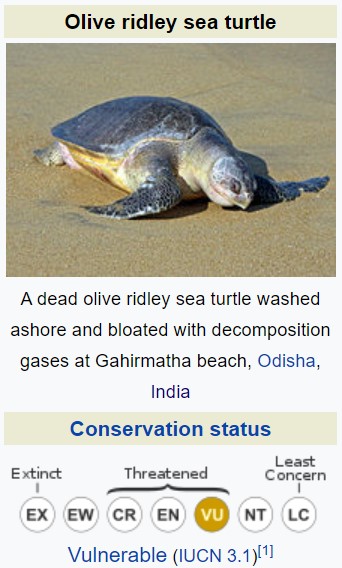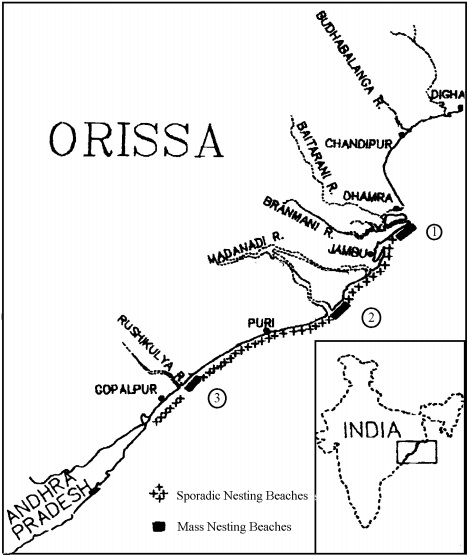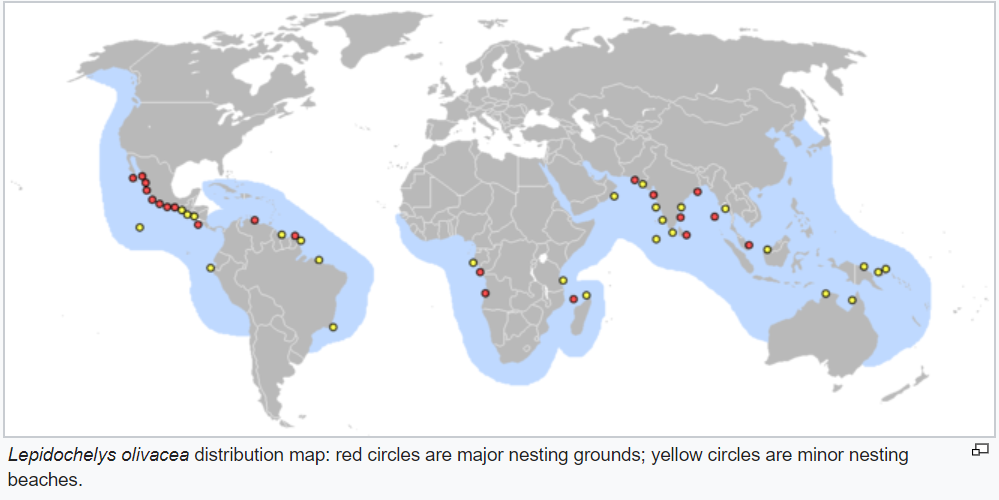Focus: GS-III Environment and Ecology
Why in news?
Restrictions in place for the COVID-19 threat is saving lakhs of Olive Ridley turtles from possible intrusion by humans, especially tourists, while they are continuing mass nesting at Odisha’s Rushikulya rookery.

What is different this year?
- This event normally attracts hundreds of people to the spot, with Forest Department personnel spending considerable time and effort in controlling the crowds of tourists as well as locals. But this year, the COVID-19 lockdown has ensured no such disturbance occurs for the turtles.
- Two trawlers, two speed boats and a country boat are being used by Forest Department to patrol the sea, in order to prevent fishing trawlers from plying along the coast. Trawlers did not cause any deaths of turtles as a result.
- This year, the beach has received thorough cleaning at regular cleaning long before mass nesting commenced. The Forest Department also set up 11 off-shore camps early this year to monitor the beach.
Disruptions in Nesting in the Past
- In 2019, mass nesting of Olive Ridleys did not occur in Rushikulya, in contrast to 2018, when “double mass nesting” occurred in February and April, with nesting figures rising above 4,73,000.
- October 2018’s Cyclone Titli, and the floods that followed, left huge piles of waste over about 8 km of the Rushikulya coast, which had to be cleaned with excavators. It has been estimated that minute particles of the waste had remained, keeping the nesting Olive Ridleys away in 2019.
Olive Ridley Sea Turtle
- The olive ridley sea turtle (Lepidochelys olivacea), also known commonly as the Pacific ridley sea turtle, is a species of turtle in the family Cheloniidae.
- The species is the second smallest and most abundant of all sea turtles found in the world.
- This turtle and the related Kemps ridley turtle are best known for their unique mass nesting called arribada, where thousands of females come together on the same beach to lay eggs.
- The species is listed as Vulnerable in the IUCN Red List, Appendix 1 in CITES, and Schedule 1 in Wildlife Protection Act, 1972.
- Olive-ridleys face serious threats across their migratory route, habitat and nesting beaches, due to human activities such as unfriendly turtle fishing practices, development, and exploitation of nesting beaches for ports, and tourist centres.
Breeding Grounds of the Olive Ridley Sea Turtle in India
- The Gahirmatha Beach in Kendrapara district of Odisha (India), which is now a part of the Bhitarkanika Wildlife Sanctuary, is the largest breeding ground for these turtles.
- The Gahirmatha Marine Wildlife Sanctuary, which bounds the Bhitarkanika Wildlife Sanctuary to the east, was created in September 1997, and encompasses Gahirmatha Beach and an adjacent portion of the Bay of Bengal.
- Bhitarkanika mangroves were designated a Ramsar Wetland of International Importance in 2002. It is the world’s largest known rookery of olive ridley sea turtles.
- Apart from Gahirmatha rookery, two other mass nesting beaches have been located, which are on the mouth of rivers Rushikulya and Devi.
- The spectacular site of mass congregation of olive ridley sea turtles for mating and nesting enthralls both the scientists and the nature lovers throughout the world.


Threats to the Olive Ridley Sea Turtle
- Known predators of olive ridley eggs include raccoons, coyotes, feral dogs and pigs, opossums, coatimundi, caimans, ghost crabs, and the sunbeam snake.
- Hatchlings are preyed upon as they travel across the beach to the water by vultures, frigate birds, crabs, raccoons, coyotes, iguanas, and snakes. In the water, hatchling predators most likely include oceanic fishes, sharks, and crocodiles.
- Adults have relatively few known predators, other than sharks, and killer whales are responsible for occasional attacks. On land, nesting females may be attacked by jaguars. Notably, the jaguar is the only cat with a strong enough bite to penetrate a sea turtle’s shell, thought to be an evolutionary adaption from the Holocene extinction event.
- In recent years, increased predation on turtles by jaguars has been noted, perhaps due to habitat loss and fewer alternative food sources. Sea turtles are comparatively defenseless in this situation, as they cannot pull their heads into their shells like freshwater and terrestrial turtles.
- Humans are still listed as the leading threat to L. olivacea, responsible for unsustainable egg collection, slaughtering nesting females on the beach, and direct harvesting adults at sea for commercial sale of both the meat and hides.
Bhitarkanika National Park
- Bhitarkanika National Park is one of Odisha’s finest biodiversity hotspots and is famous for its mangroves, migratory birds, turtles, estuarine crocodiles, and countless creeks.
- The wetland is represented by 3 Protected Areas, the Bhitarkanika National Park, the Bhitarkanika Wildlife Sanctuary and the Gahirmatha Marine Sanctuary.
- Bhitarkanika is located in the estuary of Brahmani, Baitarani, Dhamra, and Mahanadi river systems.
- It is said to house 70% of the country’s estuarine or saltwater crocodiles, conservation of which was started way back in 1975.
Extra Information
- Kemp’s ridley turtle is the smallest of the sea turtles, with adults reaching a maximum of 75 cm (30 in) in carapace length and weighing a maximum of 50 kg (110 lb).
- The olive ridley is predominantly carnivorous, especially in immature stages of the lifecycle.
- Animal prey consists of protochordates or invertebrates, which can be caught in shallow marine waters or estuarine habitats. Common prey items include jellyfish, tunicates, sea urchins, bryozoans, bivalves, snails, shrimp, crabs, rock lobsters, and sipunculid worms.



